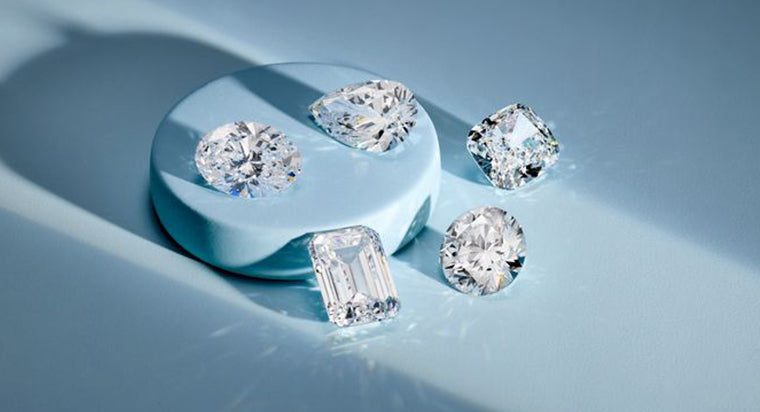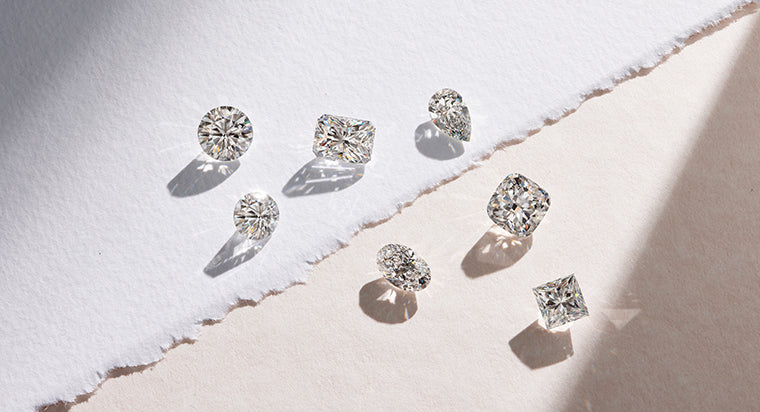Diamond Certification Types: Everything to Know

Certified Diamonds are diamonds that have been graded by a reputable gem laboratory. They are graded based on their “4 C” attributes. These attributes include cut, color, clarity, and carat weight. In order to ensure that you are getting a high-quality stone, it’s always recommended to purchase certified diamonds. Certified diamonds all have a diamond certificate, a document that describes in detail all of the most important features of the stone. A certified diamond will always have a third-party verification of their quality. This verification comes from trained gemologists who know the ins and outs of a diamond and are trained to assign it accurate grades.
TABLE OF CONTENTS
Issuing Diamond Grading Reports
Diamonds are certified by grading labs. These organizations must be engaged in scientific research. Diamond vendors (or individuals) then pay these labs to provide diamond certificates. Here are some of the most well-known and reputable labs:
- GIA: Gemological Institute of America
- AGS: American Gem Society
- EGL: European Gemological Laboratory
- IGI: International Gemological Institute
Every single one of these labs will grade the diamond’s cut, clarity, color, and carat weight.
Difference between a Diamond Certificate and a Diamond Appraisal
Diamond certificates and diamond appraisals are two terms that are commonly confused with each other. Even though some retailers might try to use a diamond appraisal instead of a diamond certificate, it’s not the same thing and there’s a huge difference between the two. A diamond appraisal is a document that simply puts a monetary value on a diamond, or on an entire piece of jewelry. It’s most often used to figure out how much is a good amount to pay for the stone’s insurance.
On the other hand, a diamond certificate doesn’t value the stone in terms of how much it’s worth. The purpose of this report is to document all of the key qualities and characteristics of the diamond. The certificate doesn’t give an opinion on how much the diamond should cost, it simply grades the diamond based on its color, clarity, cut, and carat weight.
The Best Diamond Grading Labs
The G.I.A. (Gemological Institute of America) is the world’s greatest authority on diamonds, gemstones, and even pearls. They are a nonprofit institute. The GIA has the highest standards for diamonds and education, and they are arguably the leading source of knowledge for all gems and jewelry. When you choose to get a diamond certificate from them, they have four different diamond grading reports that you can pick from. These include:
- DIAMOND GRADING REPORT - This report assesses the full 4 C’s (cut, clarity, color, and carat weight). It comes with a plotted clarity diamond. This report is best for loose, D-Z color diamonds only. The diamond’s weight should be 0.15 carats or more.
- DIAMOND DOSSIER - Again, this is a full 4 C's assessment. This report comes with a GIA report number laser inscription. It is for loose, D-Z color diamonds only. The diamonds should weigh 0.15-1.99 carats.
- DIAMOND eREPORT - This report is also a full 4 C's assessment, but it comes with a face-up diamond image. Again, it is for loose D-Z color diamonds. The diamond carat weight should be between 0.15-2.99 carats.
- DIAMOND FOCUS ™ REPORT - Their final report choice is an online report only. It comes with a full 4 C's assessment and a GIA report number laser inscription. This report is for select loose diamonds that are under the weight of 0.40 carats.
I.G.I. (International Gemological Institute) is the world’s largest independent gemstone grading organization. They assess diamonds, colored stones, and pearls too. They are the largest organization of its kind, holding authority on 18 laboratory locations around the world. Other than grading, they also have 14 schools of gemology to empower professionals through diverse scholastic programs. When you choose to get a diamond certificate from them, they have four different diamond grading reports that you can pick from. These include:
- DIAMOND GRADING REPORT - This report grades the diamond 4 C’s (cut, carat weight, color, and clarity). As well as the polish, symmetry, and fluorescence.
- HEARTS AND ARROWS REPORT - Like the Diamond Grading Report, this is a detailed assessment of the 4 C's. This report is only for diamonds that are precisely cut so that their facet reflections look like hearts from the pavilion side, and arrows from the crown side.
- COLORED DIAMONDS REPORT - This report is also a 4 C's assessment, but it is focused on natural, lab, and simulant fancy colored diamonds. Identification for colored diamonds is extremely complex, so only experienced IGI graduate gemologists can grade these.
- LABORATORY GROWN DIAMOND REPORT - Their final diamond report choice is the same as their (Natural) Diamond Grading Report. It comes with a IGI laser inscription of their identification number and the words "lab grown", and note of origin. This report is for "man made," "created," or "lab grown" diamonds.
At With Clarity we offer IGI certificates only for our lab grown diamonds.
Benefits of Certified Diamonds
When you purchase a certified diamond, you know that they have been verified for their quality. You will actually be purchasing a diamond based on its characteristics and attributes, instead of just trusting the sales pitch of the retailer with no actual proof. Diamond certificates provide an accurate representation to the consumer of what the diamond will look like in real life. Here are some additional benefits of certified diamonds
- Certified diamonds have a higher value than non-certified diamonds, especially in terms of resale and upgrading purposes.
- Certified diamonds have a much simpler comparison process. This is because it’s significantly easier to compare diamonds that have been certified based on the 4 C’s than it is to rely on visual inspection.
- Consumers can shop with online retailers with confidence, instead of scepticism.
- Significant savings can come from choosing certified diamonds, especially when bought from online retailers instead of in a jewelry store .
Overall, diamond certification is a very important factor to consider when purchasing a diamond. If you buy a non-certified diamond, you have to trust what the seller is pitching, which can be biased and not the truth. However, if the diamond is certified by a reputable grading lab such as the G.I.A., you know the quality and characteristics of the diamond right away. It helps you make an informed and logical decision when choosing and buying a natural diamond. Comparing several GIA diamonds will also allow you to compare different diamonds based on the same characteristics. Overall, buying a certified diamond will give you peace of mind and satisfaction in your purchasing decision. Shop our collection of loose diamonds or pair a certified diamond with an engagement ring.
FAQs
What are the best diamond grading labs?
The Gemological Institute of America (GIA) is widely regarded as one of the best diamond grading labs. Known for its stringent grading standards, the GIA is recognized globally for its expertise and reliability. GIA diamond grading reports are highly valued and trusted by the industry and consumers alike, providing accurate and detailed assessments of a diamond's quality.
What does a diamond appraisal tell you?
A diamond appraisal provides an assessment of a diamond's value based on various factors. It typically includes information about the diamond's physical characteristics, such as its cut, clarity, color, and carat weight. The appraisal may also include details about the diamond's shape, measurements, and any unique features. Additionally, the appraisal will provide an estimated monetary value for the diamond based on current market conditions.
Do all diamonds come with a certificate?
No, not all diamonds come with a certificate. Certification is optional, and not all diamonds undergo the evaluation process by a gemological laboratory. Diamonds without a certificate may still be of high quality, but the absence of certification makes it difficult to verify their characteristics and value objectively. It's generally recommended to purchase certified diamonds to have a reliable assessment of their quality.
What are the benefits of certified diamonds?
Certified diamonds offer the benefit of providing certainty about the diamond's quality through an independent assessment. This helps buyers make informed decisions and ensures transparency in the diamond market. The certification documentation includes detailed information about the diamond's characteristics, allowing buyers to understand and compare different stones easily. Additionally, certified diamonds tend to have higher resale value as their quality and authenticity are documented, providing confidence in their investment potential.









